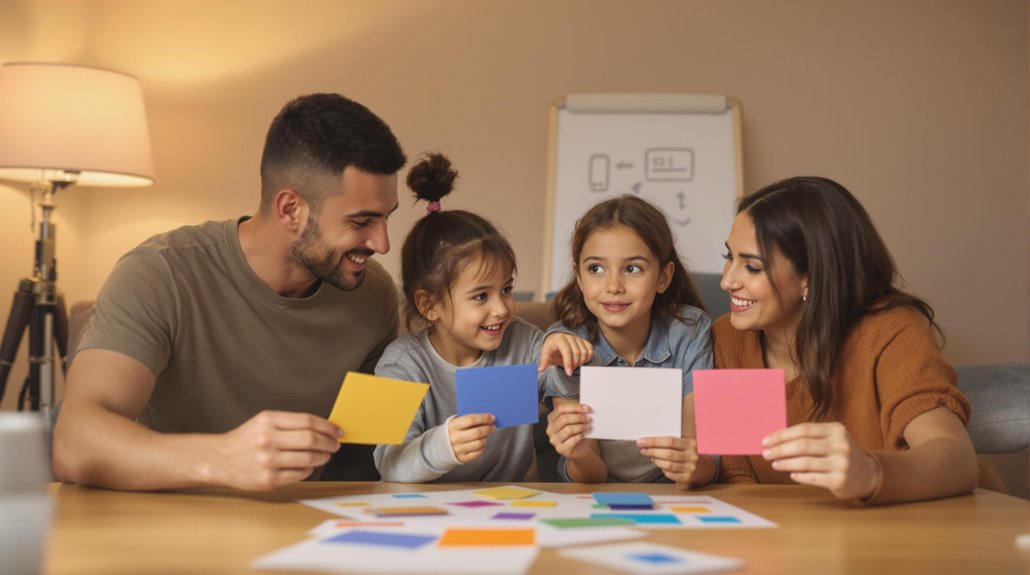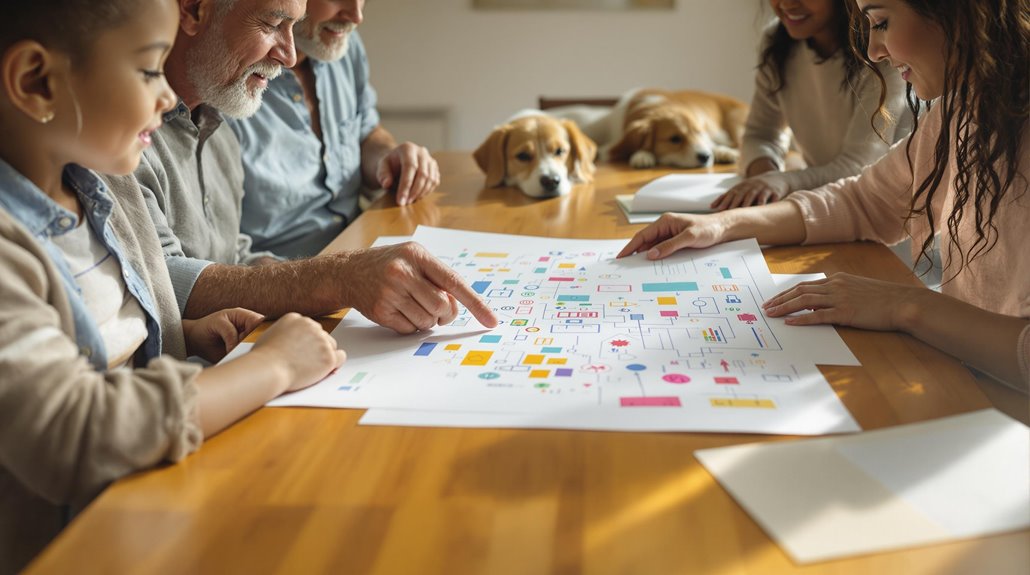How to Create and Use a Family Communication Code for Emergencies

Start by picking unique and simple code words that your family can easily remember. These codes should be contextually ambiguous, fitting seamlessly into everyday conversation for discreet communication. Involve everyone, especially children, by discussing their use during regular family meetings. Practice your code through quarterly drills and get feedback to keep it effective. Regularly update the code to stay relevant as your family evolves. Make sure you're signed up for local emergency alerts and keep your emergency supplies checked. This preparation not only enhances safety but also builds trust and confidence within your family. Uncover more on enhancing family safety.
Understanding Family Communication Codes
In the domain of family safety, understanding family communication codes is fundamental. These codes are more than just a clever strategy; they're a necessary tool for guaranteeing safety during emergencies. By establishing a unique code word or phrase, your family can verify identities and distinguish between trusted members and potential threats. This simple yet effective method is vital, especially when technology can mimic voices. Family communication codes elevate security against scams, providing a layer of protection in a virtual environment filled with impersonators. Practicing and regularly reminding your children and teens about the code reinforces its importance, empowering them to use it effectively in high-stress situations. This practice not only improves their awareness but also builds confidence in recognizing and responding to potentially dangerous scenarios. Moreover, implementing a family code word fosters open communication and trust within the family. It allows everyone to discreetly signal for help or express discomfort without attracting unwanted attention. Open dialogue about these codes guarantees that each family member understands their role in protecting one another, thereby strengthening the bonds of trust and security. By prioritizing these codes, you're actively safeguarding your family's well-being. Additionally, incorporating specific items for natural disasters in your emergency survival kits can further enhance your family's preparedness for various scenarios.
Choosing a Memorable Code
Having laid the groundwork for understanding family communication codes, the next step is choosing a memorable code. It's vital to select code words that are unique, like "bubblegum," to guarantee they stand out during an emergency. This makes it easier for family members to recall and use them when implementing your emergency plan. The chosen word should be simple enough for everyone, including young children, to remember even under stress.
To reinforce the significance of your code words, integrate them into casual conversations. By doing this, you improve their familiarity and ensure that all family members can recognize and remember them quickly. Consistent practice is key; regularly review and practice the code during family meetings or drills. This helps to keep the communication strategy fresh in everyone's minds and guarantees that you're all prepared for any situation.
When choosing a code word, make sure it's contextually ambiguous so it won't be easily guessed by outsiders. This adds an extra layer of security to your emergency plan. By carefully selecting memorable and secure code words, you're taking a fundamental step in safeguarding your family's communication during emergencies. Remember to create a hierarchy of communication methods in case one fails, ensuring your family always has a backup plan ready.
Involving All Family Members

Engaging every member of your family in creating a communication code is crucial for guaranteeing everyone is on the same page during emergencies. By involving all family members, you assure that everyone knows and understands the family emergency communication plan, enhancing its effectiveness. Here's how you can get everyone involved:
- Set Up Regular Family Meetings: Schedule meetings to discuss emergency preparedness, guaranteeing the code is up-to-date and relevant. Use these sessions to clarify any doubts and agree on meeting places for emergencies.
- Encourage Input From Everyone: Engage children by letting them contribute ideas for the code. This fosters a sense of ownership and responsibility regarding safety and security. When kids feel their input is valued, they're more likely to remember and use the code properly.
- Clarify When to Use the Code: Make certain everyone knows the context and appropriate circumstances for using the code. This prevents confusion during stressful situations and guarantees quick, effective action.
Remember to sign up for local emergency alert systems to stay informed about any potential hazards in your area. The goal is to create a resilient family emergency communication plan that grows with your family. By involving everyone, you're fostering a culture of preparedness and guaranteeing safety and security for all.
Practicing Regularly
Once your family is involved in creating the communication code, it's essential to practice regularly to guarantee everyone knows how to use it effectively. Regular practice assures that each family member is familiar with the code and confident in using it during emergencies. Scheduling drills at least quarterly can reinforce the importance of the plan and highlight any areas needing improvement or clarification.
In these practice sessions, involve your children. This not only helps them understand the significance of the code but also improves their ability to recall it under stress. Children can become more engaged when you incorporate real-life scenarios into the drills. This approach provides context, making it clear when and how to use the code effectively.
Consistent review and updates of the communication code during family meetings are also critical. This keeps the code relevant and memorable, allowing it to adapt to any changes in family dynamics or potential threats. Regularly checking supplies and ensuring everyone is aware of their location can enhance the preparedness of the entire family. Encourage everyone to share feedback on the drills to guarantee the plan remains practical and efficient. Regular practice is a key component in making your family's emergency communication plan a reliable tool when it matters most.
Integrating the Code Into Daily Life

To make the family communication code a seamless part of your everyday life, start by weaving it into casual conversations. Regardless of whether you're out shopping or just chatting at home, bring up the code word casually. This helps every member of the family get comfortable with it and see it as a natural part of your communication and emergency plans. By integrating the code word into playful contexts, such as games or friendly challenges, you not only reinforce its importance but also make it memorable.
Here are some practical steps to help integrate the family communication code into daily life:
- Role-Playing Exercises: Create scenarios at home where each family member practices using the code word. This not only strengthens their understanding but also enhances their confidence in real-life situations.
- Tech Reminders: Use family group chats or shared apps to send reminders or updates about the code word. This guarantees every member has the contact information and keeps the concept fresh.
- Family Meetings: Regularly remind children and teens about the code word during family gatherings. This keeps it relevant in their daily activities and aligns everyone with your emergency plans.
Incorporate emergency preparedness for children by discussing natural hazards and specific actions they should take during such events. With these strategies, your family will be better prepared and connected.
Overcoming Communication Challenges
Establishing a family code word serves as a powerful tool for overcoming communication barriers during emergencies. By having a specific code word, you can verify the identity and intentions of family members quickly and effectively. This becomes essential in high-stress situations where clear and fast communication is necessary. It helps confirm that you're speaking to the right person, especially when AI voice spoofing scams are a threat. Regularly practicing your code word guarantees that everyone, including children, can recall it instantly when an emergency arises. This practice solidifies its importance and assures that no one hesitates to use it when needed. Incorporate the code word into everyday conversations to make it natural and unassuming. This way, it won't draw unnecessary attention if used during emergencies but will still be top of mind for all family members. Additionally, creating contextually ambiguous code phrases is another strategy to communicate discreetly in uncomfortable or dangerous situations. Such phrases allow you to seek help or alert family members without tipping off potential threats. Having emergency lighting tools available can enhance your family's ability to navigate emergencies safely and with confidence, confirming everyone's identity is secure.
Adapting to Changing Needs
As your family evolves, it's vital to adapt your communication code to meet changing needs and circumstances. Regularly updating the code guarantees it remains effective for all family members, especially when new ones are added or as children grow and their understanding deepens. This adaptability is significant in preparing for emergency situations, such as natural disasters, where clear, relevant communication can make a remarkable difference. In addition to updating communication codes, ensure you have non-perishable food and other essentials to stay prepared during emergencies. Here's how you can adapt your communication plan:
- Review and Update Regularly: Reflect on changes in family dynamics, like new family members or shifts in children's development. Adjust the code to confirm everyone can understand and use it effectively.
- Incorporate Cultural Relevance: Use culturally meaningful terms or phrases that resonate with family members, making the code memorable and easier to recall during emergencies.
- Gather Feedback: During practice sessions, solicit input from family members. This will help refine the communication code, confirming everyone is comfortable and confident in using it.
As your children's social environments change, keep the plan flexible. Modify it to address new scenarios they might face, enhancing its effectiveness. Schedule regular family meetings to discuss the code's relevance, reinforcing its role in emergency preparedness.
Enhancing Family Safety
Building trust within your family is key to improving safety during emergencies. By establishing a family communication code, you create a quick and reliable method to guarantee your loved ones' safety, particularly against potential threats like voice spoofing scams. This code acts as a safeguard, allowing family members to verify each other's identity and intentions in dangerous situations.
Regular practice of this code empowers everyone, especially children and teens, to use it without hesitation. It becomes an essential tool they can rely on when confronted with a potentially threatening scenario. By incorporating the family communication code into everyday conversations, you make its use more natural and memorable. This normalization guarantees it won't be forgotten in high-stress circumstances.
Make certain all family members know the importance of this code word. It fosters an environment of trust and open communication, enabling them to discreetly signal for help when needed. Alongside having up-to-date emergency phone numbers, the family communication code strengthens your comprehensive safety plan. In emergencies, knowing everyone can securely communicate their status and needs improves the collective safety of your loved ones, giving you peace of mind.




